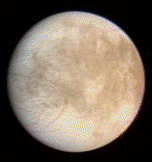The Gas Giants: Jupiter and Saturn
At the solar distance of Jupiter and Saturn, 5.2 and 9.5 times further than the Earth-Sun distance (an `AU'), the early solar nebula was much colder. Planetesimals forming from accreting grains could accumulate even the very light materials such as water ices, from which to grow. Planetesimals closer to the Sun could NOT accumulate water, since it was hotter and fully vaporized at such near solar distances. The planetesimals forming further from the sun would have grown to be the largest in the shortest time because of all the ices available for formation. Once these proto-planets achieved masses 15x Earth, they would accumulate the very lightest elements, Hydrogen and Helium. Hydrogen and Helium make up 98% of the local nebular material, so Jupiter and Saturn were able to accumulate essentially all available material for planet building.
 Why didn't Saturn grow as large as Jupiter?
Why didn't Saturn grow as large as Jupiter?
All things being equal, Saturn should have grown as large as
Jupiter. It didn't however because out at nearly 10 AU
distance, the amount of material in the Solar nebula was considerably
less than was available to Jupiter at just 5 AU.
 Where did Jupiter and Saturn's moons come from?
Where did Jupiter and Saturn's moons come from?
Recall, Mars captured its two small moons from the asteroid belt.
It's likely that many of Jupiter's and Saturn's moons were also
captured. However, most scientists seem to think that the four
very large Galilean moons of Jupiter and possibly Saturn's very
large moon, Titan, were in fact formed from left over planetary
material of their host planets. This means the largest planets
may have formed just like a small solar system of their own.
Where did Jupiter and Saturn's rings come from?
The rings are not left over debris from the formation
of these planets. Their delicate nature of mostly icy
volatiles (easily evaporated material) would never have
survived during the planet building stages of Jupiter and Saturn.
Instead, they likely come from capturing material from
close approaching comets and tidally-ripped up bits of moons
or asteroids.
 The Collision of Comet Shoemaker-Levy 9 with Jupiter
The Collision of Comet Shoemaker-Levy 9 with Jupiter
The comet was first identified on a photograph taken 24 March
1993. Subsequent photographs showed that the comet was split into
many separate fragments. Before the end of March it was realized
that the comet had made a very close approach to Jupiter in mid-1992.
By April, 1993, it was found that the comet was in orbit around Jupiter
and would to impact Jupiter in 1994.
As many as 22 individually tracked fragments of the comet SL9 impacted Jupiter. They were labeled fragments A through W. The image shown here was taken by HST on July 21 1994, about 2.5 hours after R's impact. A large dark patch from the impact of fragment H is visible rising on the morning (left) side. Proceeding to the left, other dark spots were caused by impacts of previous fragments.